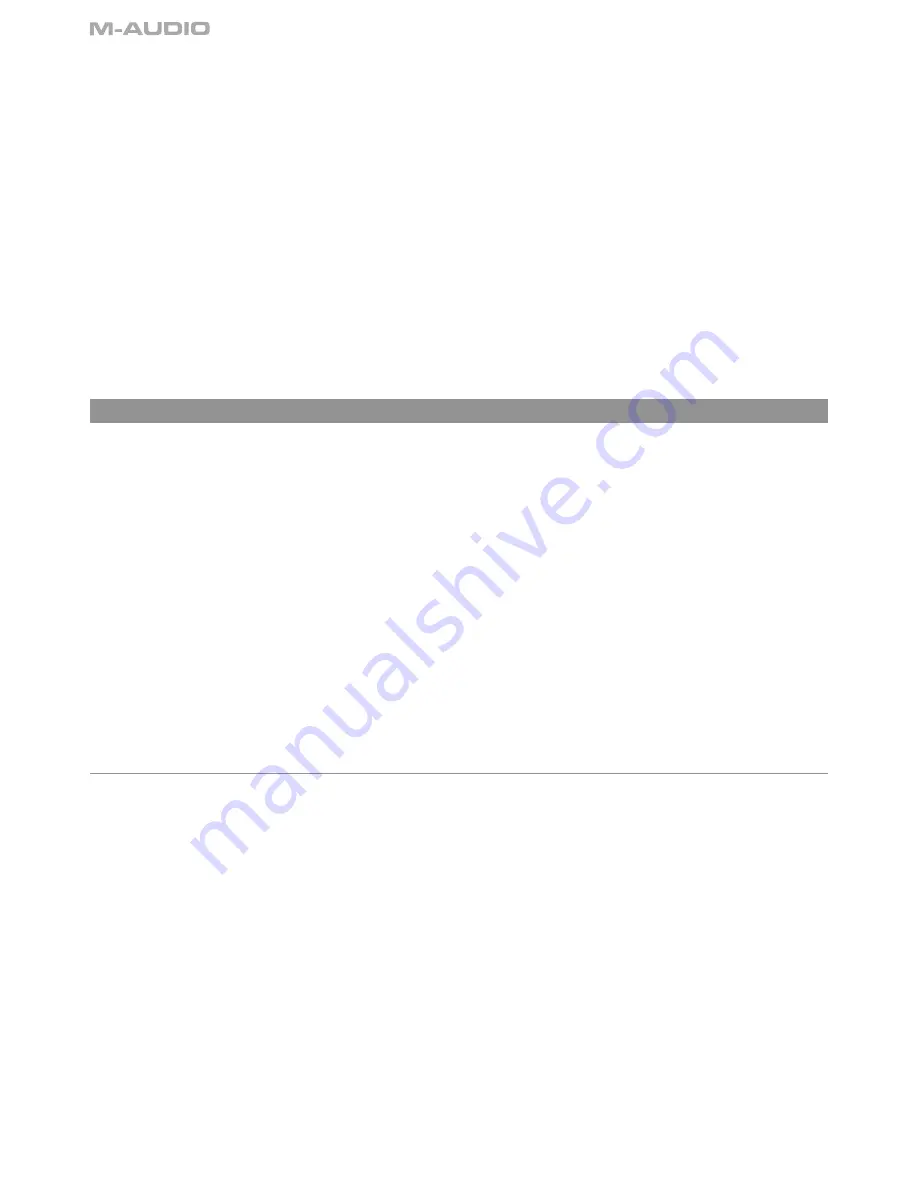
20
To exit Scrub mode, do any of the following:
• Press STOP or SCRUB on ProjectMix I/O.
• Press the spacebar.
• Press escape (F8/ESC).
• Press any other transport button (RWD, FF, STOP, PLAY, REC).
Shift Button (SHIFT)
The SHIFT button functions as an OPTION button in Pro Tools.
Transport Buttons (RWD, FF, STOP, PLAY, REC)
When the Audio During Fast Forward/Rewind option is selected in the Operation Preferences of Pro Tools, you will hear scanned audio (as on
a CD player) during rewind and fast forward.
If the Audio During Fast Forward/Rewind option is not selected, you can continuously rewind or fast forward by holding down the corresponding
RWD or FF button. You can also rewind or fast forward incrementally by repeatedly clicking the corresponding button. The size of these
increments depends on which Display mode is currently selected:
<
Bars/Beats
: Moves to start of previous or next bar.
<
Min/Sec
: Moves in one-second increments.
<
Timecode
: Moves in one-frame increments.
<
Feet Frames
: Moves in one-foot increments.
<
Samples
: Moves in one-sample increments.
Cubase Mode
To enter Cubase mode
: Hold down the AUX 2 button while powering on the unit. The mode will be confirmed in the LCD display when the
ProjectMix I/O has initialized. Cubase mode will also work with Steinberg's Nuendo software.
PC Setup
: With the ProjectMix I/O in Cubase mode, launch the application and choose Device Setup from the Device menu. Next, click on the
Add/Remove tab and a list of products will appear. Click on Mackie Control, then click Add. Click on the Setup tab and click Mackie Control
in the left column. Choose Control for both the input and output MIDI ports. Then select VST Audio Bay and set the Master ASIO Driver to
ProjectMix Multichannel, then click Apply. You can then close the Device Setup window and the ProjectMix I/O will now control Cubase.
Mac Setup
: With the Project Mix I/O in Cubase mode, launch the application and choose Device Setup from the Device menu. Select the +
sign in the upper left corner of the Device Setup window. Click on Mackie Control to display the Controller Setup window. Choose Control for
both the input and output MIDI ports. Then select VST Audio Bay and set the Master ASIO Driver to ProjectMix Multichannel, then click Apply.
You can then close the Device Setup window and the Project Mix I/O will now control Cubase.
NOTE
: Many of Cubase's features consist of multiple pages of editing parameters. To move between multiple pages, hold the ALT button and
press the
t
BANK or BANK
u
button.
(In most cases of multiple-page parameter controls specific to Cubase, we have attempted to document the full range of editing parameters.
(For example, the FX send and EQ parameters). However, many VST instruments and plug-ins can contain in excess of 50 pages of parameters;
this, combined with the sheer number of plug-ins and VST instruments available, makes it nearly impossible to document them all. We have
therefore focused this documentation on those control aspects specific to the program itself. We have not documented the functions that are
obvious and covered elsewhere in this manual, such as channel faders, MUTE, SOLO, SEL, REC and transport buttons.)
To change between pages press the ALT+
t
BANK or ALT+ BANK
u
combination.
How the ProjectMix I/O Control Surface Works with Cubase
Aux 1 Button (AUX 1): FX Send
Page 1:
Encoders 1 – 8 control aux send levels 1 – 8 on selected channel
Page 2:
Encoders 1 – 8 control aux send off/on 1 – 8 on selected channel
Page 3:
Encoders 1 – 8 control aux send pre/post 1 – 8 on selected channel
Page 4:
Encoders 1 – 8 scroll through the send assignments on selected channel
Aux 2 Button (AUX 2): Edit FX
Page 1:
Encoder 1 scrolls through FX 1 – 8
Encoder 2 turns selected FX off/on
Encoder 3 selects which effect your encoders will edit
Cubase Mode






























